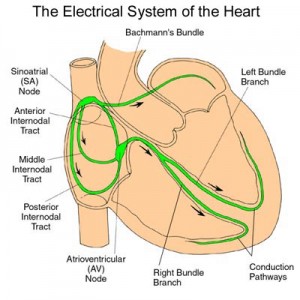New information on a heart problem that is present in many of the adult patients with myotonic dystrophy – atrial flutter. This is the heart beating too fast in the upper chambers of the heart. This new information from France gives an over view and possible treatments for this symptom. Sorry the whole article is not available for free!
Atrial flutter in myotonic dystrophy type 1: Patient characteristics and clinical outcome.
Author information
- 1AP-HP, Pitié-Salpêtrière Hospital, Myology Institute, Paris, France; AP-HP, Cochin Hospital, Department of Cardiology, Paris Descartes University, Paris, France; Pierre and Marie Curie University, Paris, France. Electronic address: karim.wahbi@aphp.fr.
- 2AP-HP, Henri Mondor Hospital, Department of Cardiology, INSERM U 955, Paris Est Creteil University, Creteil, France.
- 3InParys Clinical Research Associates, Saint Cloud, Paris, France.
- 4AP-HP, Pitié-Salpêtrière Hospital, Myology Institute, Paris, France.
- 5Department of Histology, AP-HP, CHU Henri-Mondor, Paris, France.
- 6AP-HP, Cochin Hospital, Department of Cardiology, Paris Descartes University, Paris, France; AP-HP, Avicenne Hospital, Department of Cardiology, Paris XIII University, Bobigny, France.
- 7AP-HP, Cochin Hospital, Department of Cardiology, Paris Descartes University, Paris, France.
Abstract
The prevalence and the incidence of atrial flutter in patients with myotonic dystrophy type 1 (DM1) and the most appropriate strategies for its management are unknown. We retrospectively included in the DM1 Heart Registry 929 adult patients with DM1 admitted to our Institutions between January 2000 and September 2013. We selected patients presenting with atrial flutter and analysed data relative to the occurrence of arterial thromboembolism, severe bradyarrhythmias and atrial flutter recurrences. Atrial flutter was present in 79 of the 929 patients included in our Registry, representing a 8.5% prevalence. Patients with atrial flutter were older, had a higher muscular disability rating scale score and had higher prevalence of other cardiac manifestations of DM1. Sixty patients presented with a first episode of atrial flutter, representing a 4.6% incidence. Severe bradyarrhythmias requiring permanent pacing were present in 4 patients (6.7%). Over a 53 ± 28 months mean follow-up duration, 2 patients (3.3%) had ischaemic stroke and 12 (20%) had atrial flutter recurrences. Patients who underwent radiofrequency ablation were more frequently free of atrial flutter recurrence than other patients (95 vs. 61%; HR = 0.17; P = 0.04). Atrial flutter is a common manifestation of DM1, potentially complicated by arterial thromboembolism or severe bradyarrhythmias. Radiofrequency catheter ablation is associated with a lower risk for recurrences


